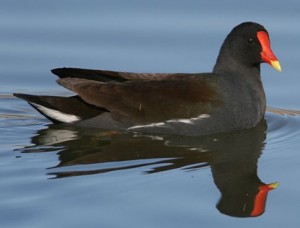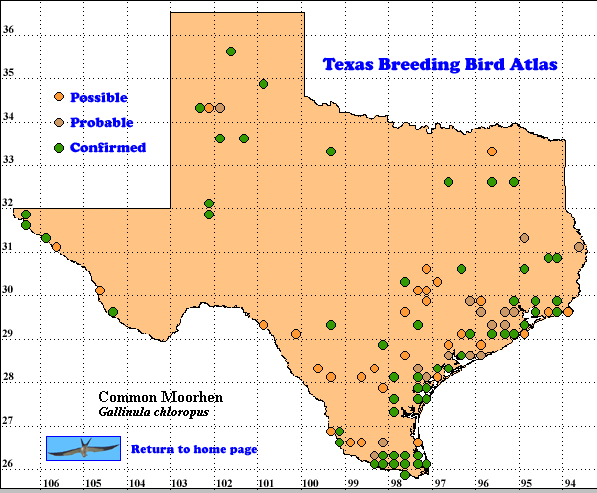Formerly known as the “Common Gallinule” or the “Florida Gallinule”, the Common Moorhen has the widest range of any species of rail (Oberholser 1974). It can be found throughout temperate and tropical regions of Eurasia, Africa, and the Americas; plus it inhabits a number of oceanic islands including the Hawaiian archipelago (Bannor and Kiviat 2002). The subspecies found across mainland North America, including Texas, is G. c. cachinnans (Taylor 1998).
Despite the breadth of its range, the moorhen is poorly recorded by most bird censuses. For example, Breeding Bird Survey counts in Texas conducted over 4 decades recorded an average of <1 moorhen per inland survey route (Sauer et al. 2005). Scientists in Ohio concluded that the most effective census method was to play recorded moorhen vocalizations and count the number of male birds responding (Brackney and Bookhout 1982). This technique apparently has not been tried in Texas. Thorough searches for nests may also give some indication of abundance. In south Texas, Cottam and Glazener (1959) located 155 nests in 97.9 ha (242 acres) of wetland, although some of these could have been renestings by pairs whose previous nests were destroyed.
DISTRIBUTION: In Texas, TBBA records confirmed breeding for every atlasing region except West Edwards Plateau, but even there indications of possible breeding were noted. Clearly, breeding is concentrated in two regions: south Texas and upper Texas coast. More than two-thirds of the TBBA reports of confirmed breeding were from these areas. Most moorhens breeding in Texas are probably non-migratory residents; the state hosts wintering individuals as well (Oberholser 1974, Greij 1994).
SEASONAL OCCURRENCE: TBBA records of eggs with nests or of chicks are all from June and July. A bird apparently sitting on eggs was spotted on May 24 in the Trans-Pecos (latilong 29104), and an earlier published report documented nests with eggs in mid-August (Cottam and Glazener 1959, TBBA data). Breeding ecology has been more thoroughly studied in neighboring southwestern Louisiana; there egg laying takes place from early April through early August (Helm et al. 1987). Notably, downy chicks have been reported in December and February in Florida (Taylor 1998). This suggests winter breeding is possible among moorhens inhabiting similar latitudes in Texas.
BREEDING HABITAT: In the Midwest where moorhens had a choice of wetland types, they reached their highest nesting densities on semipermanently flooded wetlands with narrow-leaved, persistent emergent vegetation, an abundance of submergent aquatic plants, and a 1:1 ratio of cover to open water (Brackney and Bookhout 1982).
As long as suitable cover is available, however, they may nest in a variety of fresh water environments (Greij 1994). In Texas, moorhens have been recorded nesting in inland and coastal marshes, marshy lake shores, swamp edges, playa lakes, and oxbow ponds (Simmons 1915, Cottam and Glazener 1959, Oberholser 1974, TBBA data).
Nests are oval platforms of emergent leaves and stems and are usually constructed within a clump of emergent plants or on top of a mat of floating vegetation. They may also be built in woody plants near water (Greij 1994, Taylor 1998). In Texas, reported water depths at the nest site range from 7.6-76 cm (3-30 in) while eggs in the nest lie 5-30 cm (2-12 in.) above the water (Simmons 1915, Cottam and Glazener 1959). Sham nests or platforms are usually built prior to the egg nest (Greij 1994).
STATUS: The TBBA map shows that moorhens breed throughout much of Texas. This is a sharp contrast to previously published maps of the species distribution. Oberholser (1974) showed breeding by moorhens only in the eastern half of Texas and in the El Paso area. Greij (1994) illustrates a broader distribution in west Texas, including nearly all the Trans-Pecos. Neither of these maps includes the Panhandle or south plains within the moorhens’ breeding range. Nesting in the Panhandle was not reported until 1976 (Seyffert 2001). Other breeding bird atlases have also commented on apparent recent range expansions, particularly in northeastern North America (e.g. Erskine 1992).
Moorhens are legal game in a number of states, including Texas. Between 1977 and 1992, an average of slightly more than 1,800 “gallinules” were harvested in Texas; this figure includes both the Purple Gallinule and the Common Moorhen (Greij 1994).
It is unclear how human alterations to the landscape in Texas or elsewhere have affected the moorhen. Some authors stress the impact of loss of wetlands on the bird (Greij 1994). On the other hand, moorhens have shown adaptability by nesting in manmade environments such as mining settling pools, rice fields and urban ponds (Helm et al. 1987, Taylor 1998).
Text by Brett K. Bannor (ca. 1999, posted with updates 2006)
Literature cited.
Bannor, B. K., and E. Kiviat. 2002. Common Moorhen (Gallinula chloropus). In The Birds of North America, No. 685 (A. Poole and F. Gill, eds.). The Birds of North America, Inc., Philadelphia, PA.
Brackney, A. W. and T. A. Bookhout 1982. Population ecology of Common Gallinules in southwestern Lake Erie marshes. Ohio J. Sci. 82: 229-237.
Cottam C. and W. C. Glazener. 1959. Late nesting of waterbirds in south Texas. Trans. N. Am. Wildl. Conf. 24: 382-395′
Erskine, A. J. 1989. Atlas of the breeding birds of the Maritime provinces. Nimbus Publ. and Nova Scotia Museum, Halifax.
Greij, E. D. 1994. Common Moorhen. Pp. 144-157 in Migratory shore and upland game bird management in North America (T. C. Tacha and C. E. Braun, eds.). Int. Assoc. Fish Wildl. Agencies, Washington, DC.
Helm, R. N., D. N. Pashley and P. J. Zwank. 1987. Notes on the nesting of the Common Moorhen and Purple Gallinule in southwestern Louisiana. J. Field Ornithol. 58: 55-61. and
Oberholser, H. C. 1974. The bird life of Texas, University of Texas Press, Austin.
Sauer, J. R., J. E. Hines, and J. Fallon. 2005. The North American Breeding Bird Survey, results and analysis 1966-2005. Version 6.2 2006. USGS Patuxent Wildlife Research Center, Laurel MD < http://www.mbr-pwrc.usgs.gov/bbs>
Seyffert, K. D. 2001. Birds of the Texas Panhandle. Texas A&M University Press, College Station.
Simmons, G. F. 1915. On the nesting of certain bird in Texas. Auk 32: 317-331.
Taylor, B. 1998. Rails: a guide to the rails, crakes, gallinules and coots of the world. Yale University Press, New Haven, CT.

